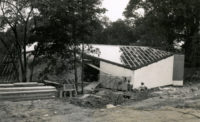Philip Beesley takes the same core idea as the point of departure both for his architecture and his otherworldly installations: the shared experience of public space. “How architecture makes a place fundamentally,” says Beesley, “and the collective experience of dwelling, encounter, and sharing stands at the core of both practices.” He describes his installations, which float above visitors, as “unapologetically experimental” and as seeking to change how we interact with the built environment. Composed of light plastics such as acrylic and polymer, along with glass and electronic systems, the sculptures from his Ephiphyte series feature reactive electronic sensors that make parts of the installation twitch when visitors draw near. Small flasks he calls “proto-cells” contain various chemical reactions—most notably, substances that capture carbon dioxide from the air. These complex sculptures, developed in collaboration with electrical, robotic, and chemical engineers, are still in early stages of development. Beesley aims for them to acquire their own intelligence, behavior, and metabolism. For the time being, they still provide a tangible way for the public to interact with an organic and sensitive architecture. And, unlikely as it may seem, this experimental work informs the more conventional built projects of Beesley’s Toronto-based practice. His Niagara Credit Union, for example, features a lightweight branching canopy and gathering space not unlike his sculptures. Above all else, he’s confident about how our society is developing increasingly powerful tools that connect us to each other and the environment. Effortlessly checking temperature or pollution levels on our smartphones may be just the beginning, he says. “The new ways that we’re able to tune into our surroundings should foster optimism.”
Philip Beesley

Composed of light plastics such as acrylic and polymer, along with glass and electronic systems, the sculptures from his Ephiphyte series feature reactive electronic sensors that make parts of the installation twitch when visitors draw near.
Photo © PBAI

Small flasks he calls 'proto-cells' contain various chemical reactions'most notably, substances that capture carbon dioxide from the air.
Photo © PBAI

Niagara Credit Union Exterior
Photo © PBAI

Niagara Credit Union Interior
Photo © PBAI



Post a comment to this article
Report Abusive Comment